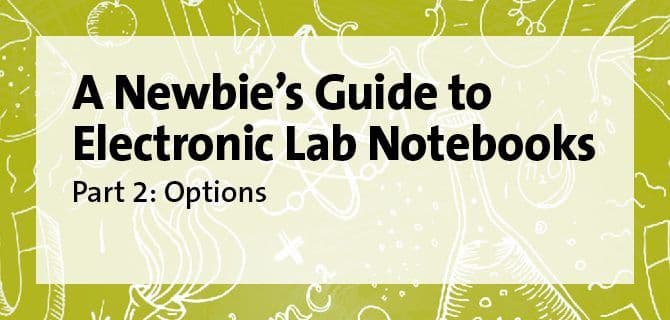Now that the basic lab notebook has been defined as a ubiquitous, primary source of documentation for an experiment (see Part 1), it’s time to look at the electronic laboratory notebooks, or ELNs. With mobile devices becoming increasingly popular — from smartphones to laptops and tablets — it’s not surprising that some researchers may prefer, […]

Now that the basic lab notebook has been defined as a ubiquitous, primary source of documentation for an experiment (see Part 1), it’s time to look at the electronic laboratory notebooks, or ELNs. With mobile devices becoming increasingly popular — from smartphones to laptops and tablets — it’s not surprising that some researchers may prefer, or at least want to look into, using their personal electronics for lab work.
Even the most fundamental ELN boasts features far and above any of its paper ancestor. Basic ELN features include the ability to search and index entries, link relevant data and notes, copying and importing files, and storing images, audio, video, sketches, notes, formulas, and data. And some ELNs can do much more, having increased functionality compared to the original purpose of a lab notebook; able to summarize patterns in data or fish out minutiae in experiments. This is to say nothing of improving legibility.
Unlike a paper lab notebook, the variations of ELNs can seem endless. ELNs can be free or paid, customized or generic, open or closed, software or webware based. So what should prospective users consider? Cost, provided support, compatibility with the devices you already use (PC vs Mac), user friendliness, lab or legal rules, security, and data storage are just a few top concerns for researchers.
There is an assortment of options and price points available for dedicated, paid ELN providers. While Berlin-based labfolder offers ELN services from tens of euros a month to Lake Forest-Calif-based LABTrack, which provides ELN options ranging from several hundred to a few thousand U.S. dollars.
But for those with smaller budgets, like most graduate students and postdocs, cost is a huge factor in deciding on an ELN. Fortunately, there are now good, generic, and free options available. Some note-taking applications can be used as ELNs, such as Microsoft’s OneNote, AquaMinds’ NoteTaker, Google Docs, and Evernote.
Using a generic option, however, may not always be the best option for chemistry researchers, especially when considering the specialized language used in chemistry equations. This is one decided advantage of traditional lab notebooks since there is no limit to what can be drawn. But there are some ELNs specialized enough for that sort of work. Cambridge, Mass.-based Labguru has one such tool. It enables drawing molecule and reaction equations, and stoichiometry tables, according to Labguru spokesman Steve Yemm.
An indisputable advantage of ELNs to traditional lab notebooks is sharing capabilities; ELNs simplify and foster collaboration between lab mates and outside labs. Traditional lab notebooks are typically required to remain in the lab. While they can be shared, doing so can be ungainly, time consuming, and costly if photocopies are needed. The ELN provides a much easier way to share information, whether it is results, protocols, or even literature review and observational notes, since most ELNs provide data storage via the cloud.
However, sharing also means openness, which raises the question about security. Putting information in the cloud enables broad access. To keep data safe, the storage provider must have a sound security infrastructure. It’s in your best interest to always check with your lab to see the exact security requirements for your ELN. Your lab might even be able to provide you with a list of approved recommendations.
Part 3, our final entry in this series, will look at how deeply ELNs have entered academic lab culture, as well as what they can offer to researchers beyond the traditional role of the lab notebook.